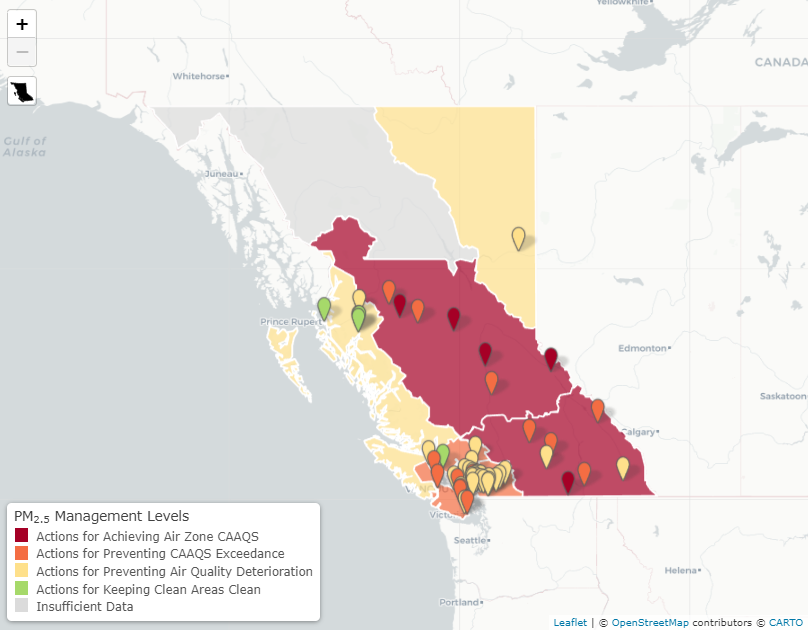Status of Fine Particulate Matter in B.C. (2020-2022)
British Columbia operates a network of air monitoring stations that measure fine particulate matter and other air pollutants. This indicator reports on the concentration of fine particulate matter from 2020-2022 and compares it to the Canadian Ambient Air Quality Standards established by the Canadian Council of Ministers of the Environment (CCME).
- Fine particulate matter is an air pollutant. Solid or liquid particles floating in the air are called particulate matter. The smallest of these particles—those that are 2.5 microns or less in diameter, or less than 1/20th the width of a human hair—are called fine particulate matter (PM2.5). Fine particulate matter comes from natural and human activities, including wildfires and emissions from residential woodstoves, open burning, forestry operations, and transportation (Government of Canada, 2012).
- Fine particulate matter can be harmful to humans. Exposure to fine particulate matter has been associated with several serious health effects including heart and lung disease (Government of Canada, 2012). Both short-term (24-hour) and longer-term (a year or more) exposures to fine particulate matter can have negative effects on human health.
The map below summarises the assigned management levels for fine particulate matter in B.C.'s air zones, as well as the levels of the pollutant at individual monitoring stations. The color of each region refers to the management level. The four management levels are: (1) green (actions for keeping clean areas clean); (2) yellow (actions for preventing air quality deterioration); (3) orange (actions for preventing Canadian Ambient Air Quality Standard exceedance); and (4) red (actions for achieving air zone Canadian Ambient Air Quality Standard). Each management level is associated with a suite of actions that become more rigorous as fine particulate matter levels approach the standard. Suggested actions for each management level are outlined in the Guidance Document on Air Zone Management (CCME, 2019). More information on Management Levels can be found below.
The map shows air quality stations with sufficient data to report for the 2020-2022 reporting period. When you click on a station, a graph appears showing both the original data and data that has been adjusted for Transboundary Flow and Exceptional Events (TF/EE). TF/EE adjustments occur when air pollutants travel from other geographic region to B.C. (TF) or when rare, natural, or human-induced events such as wildfire or volcanic eruptions impact air quality (EE). TF/EE adjustments remove the pollutants caused by these events because they are unpredictable and not part of typical/controllable emissions.
Tip: Click or tap on an air zone or monitoring station to see the status of fine particulate matter levels.
Tip: See Table 6.1 in the Guidance Document on Air Zone Management (CCME, 2019) for more information about the suggested actions for each color/management level in the map below.
Fine Particulate Matter (PM2.5): Canadian Ambient Air Quality Standard
PM2.5 levels are calculated using two statistical forms called the annual and the 24-hour metrics. The Canadian Ambient Air Quality Standards for PM2.5 are achieved when annual metrics are 8.8 micrograms per cubic metre (µg/m3) or lower, and the 24-hour metrics are 27 µg/m3 or lower.
- Fine particulate matter levels met both Canadian Ambient Air Quality Standards at 60% of assessed monitoring stations in B.C. There are two metrics for PM2.5: an annual metric and a 24-hour metric (see sidebar). The annual standard was met at 47 of the 54 stations for which valid data was obtained, while the 24-hour standard was met at 33 of the 55 stations with sufficient data for analysis.
- Fine particulate matter levels met both Canadian Ambient Air Quality Standards in four of B.C.'s seven air zones. The Coastal, Georgia Strait, Northeast, and Lower Fraser Valley air zones met both the PM2.5 annual and 24-hour standards. The Central Interior air zone exceeded the PM2.5 24-hour standard at Houston and Valemount, and the PM2.5 annual standard at Vanderhoof. The Southern Interior air zone exceeded the PM2.5 annual standard at Grand Forks. There are currently no air monitoring stations in the Northwest air zone.
What is an Air Zone?
British Columbia is divided into seven air zones. These are areas with similar air quality characteristics, issues, and/or trends.


 Your screen is too small to display the interactive map. Click to see the interactive
visualization in full-screen.
Your screen is too small to display the interactive map. Click to see the interactive
visualization in full-screen.
